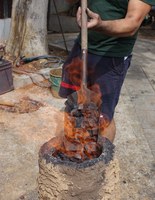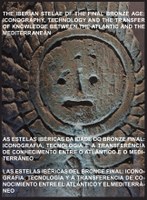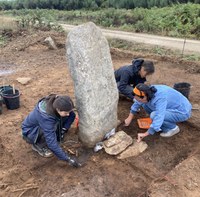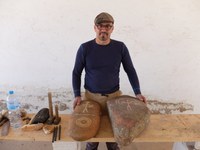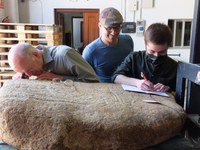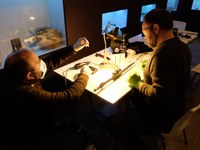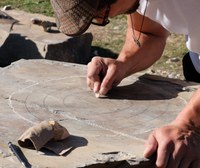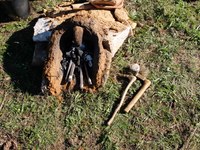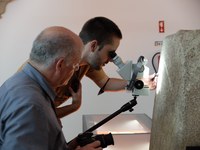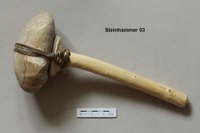International Workshop and Conference in Freiburg, 10th-11th October 2023

BOOK OF ABSTRACTS
I Project Workshop
(DFG-Project No. AR 1305/1-2)
THE IBERIAN STELAE OF THE FINAL BRONZE AGE: ICONOGRAPHY, TECHNOLOGY AND THE TRANSFER OF KNOWLEDGE BETWEEN THE ATLANTIC AND THE MEDITERRANEAN
AS ESTELAS IBÉRICAS DA IDADE DO BRONZE FINAL: ICONOGRAFIA, TECNOLOGIA E A TRANSFERÊNCIA DE CONHECIMENTO ENTRE O ATLÂNTICO E O MEDITERRÂNEO
LAS ESTELAS IBÉRICAS DEL BRONCE FINAL: ICONOGRAFIA, TECNOLOGÍA Y A TRANSFERENCIA DE CONOCIMIENTO ENTRE EL ATLÁNTICO Y EL MEDITERRÁNEO
Freiburg, 10th – 11th October 2023
Liefmannhaus der Universität Freiburg, Goethestraße 33, 79100 Freiburg im Breisgau
Introduction - The project and its first Results / Introducción–El proyecto y sus primeros resultados
Ralph Araque Gonzalez – University of Freiburg
The project " The Iberian stelae of the Final Bronze Age: Iconography, Technology and the Transfer of Knowledge between the Atlantic and the Mediterranean" (DFG No. AR 1305/2-1) and its preliminary results are presented. This project studies the so-called warrior stelae of the Late Bronze and Early Iron Age of the western Iberian Peninsula (c. 1300-800 BC), which are stone monuments depicting different motifs such as weapons, fibulae, chariots or human figures.
The objectives of the project, which began in 2021, go beyond the traditional study of the motifs and their compositions on the stelae, seeking to study the different types of support and the reasons for their choice, the technology used for their production and the relationship of the stelae with the society that created them, the fundamental basis being archaeometry and experimental archaeology.
Se presenta el proyecto “Las estelas ibéricas del Bronce Final: iconografía, tecnología y a transferencia de conocimiento entre el Atlántico y el Mediterráneo” y se dan a conocer sus resultados preliminares. Este proyecto estudia las llamadas estelas de guerrero del Bronce Final y I Edad del Hierro del occidente de la Península Ibérica (c. 1300-800 a.C.), las cuales son monumentos de piedra en los que aparecen representados diferentes motivos como armas, fíbulas, carros o figuras humanas.
Los objetivos del proyecto, iniciado en el año 2021, van más allá del tradicional estudio de los motivos y las composiciones de las estelas, buscando estudiar los diferentes tipos de soporte y las causas de su elección, la tecnología empleada para su elaboración y la relación de las estelas con la sociedad que las fabricó, siendo la base fundamental la arqueometría y la arqueología experimental.
Contexto General de las Estelas / General Context of the Stelae
Sebastian Celestino – CSIC / Instituto de Arqueología-Mérida
La evolución que han sufrido las estelas desde el descubrimiento de los primeros ejemplares son un síntoma elocuente de su propio desarrollo geográfico; así, pasaron de denominarse “extremeñas” a ser del “suroeste”, si bien tras los descubrimientos de los últimos años parece más lógico denominarlas estelas del “oeste” puesto que ocupan buena parte de la fachada atlántica peninsular. También su concepto ha cambiado sensiblemente, pues pasaron de ser “estelas de guerrero” a incorporar el personaje femenino tocado por una diadema, por lo que hablamos de estelas de guerrero y diademadas; pero también se han documentado estelas donde aparecen ambos personajes, lo que podríamos denominar como estelas mixtas.
Más elocuente ha sido el profundo cambio que ha sufrido su significado y funcionalidad. De ser entendidas como monumentos funerarios señaladores de tumbas, pasaron a considerarse cenotafios, pero también hitos en lugares de paso o una combinación de estas funciones. También es variado el significado de las representaciones, pues lo que para unos son guerreros, para otros son personajes heroicos o, más recientemente, representaciones de deidades, algo que se podría extender a las representaciones de estelas femeninas o diademadas.
Otro problema sobre el que ha sido recurrente la bibliografía es la cronología de las estelas, realizada a través de los objetos grabados en las estelas. En este aspecto, el grado de discrepancia entre los diferentes autores es más profunda, pues hay desde quienes las hacen derivar de las estelas alentejanas del Bronce Pleno hasta los que las hacen arrancar del Bronce Final, si bien el grueso de las estelas ya estaría inmerso en plena época tartésica, es decir, entre los siglos VIII y VI a.n.e. De esta forma, las discusiones sobre si los carros y las liras son de origen micénico o fueron introducidos por los fenicios, siguen estando vivas.
Hoy la tendencia es estudiar las estelas desde dos perspectivas: el territorio donde han sido halladas, y las técnicas con las que fueron elaboradas. Dos líneas de investigación que están abriendo una nueva vía para su mejor conocimiento.
The evolution that the stelae have undergone since the discovery of the first specimens is an eloquent symptom of their own geographical development; thus, they went from being called "Extremaduran" to being from the "southwest", although after the discoveries of recent years it seems more logical to call them "western" stelae, since they occupy a good part of the Atlantic coast of the peninsula. Their concept has also changed significantly, since they went from being "warrior stelae" to incorporate the female character wearing a diadem, so we speak of warrior and diademed stelae; but stelae have also been documented where both characters appear, which we could call mixed stelae.
More eloquent has been the profound change that their meaning and functionality has undergone. From being understood as funerary monuments marking tombs, they came to be considered cenotaphs, but also markers in places of passage or a combination of these functions. The meaning of the representations is also varied, since what for some are warriors, for others are heroic characters or, more recently, representations of deities, something that could be extended to the representations of female or diademed stelae.
Another problem on which the bibliography has been ambivalent is the chronology of the stelae, determined by the objects engraved on the stelae. In this aspect, the degree of discrepancy between the different authors is more profound, since there are those who make them derive from the Alentejan stelae of the Late Bronze Age to those who make them originate in the Final Bronze Age, although the bulk of the stelae would already be immersed in the Tartessian period, that is, between the VIII and VI centuries B.C.E. Thus, the discussions on whether the chariots and the lyres are of Mycenaean origin or were introduced by the Phoenicians, are still lively.
Today, the trend is to study the stelae from two perspectives: the territory where they have been found, and the techniques with which they were made. Two lines of research that are opening a new avenue for a better understanding.
El catálogo de las estelas del Instituto de Arqueología-Mérida /
The catalogue of the Iberian stelae of the Institute of Archaeology in Mérida
Pablo Paniego – Universidad Autónoma de Madrid / CSIC / Instituto de Arqueología-Mérida
Desde el Instituto de Arqueología-Mérida (IAM) del CSIC se viene realizando desde el año 2020 un completo reestudio de las estelas decoradas del occidente peninsular con el objetivo de publicar un catálogo actualizado de estas.
El proceso se puede dividir en varias fases:
- Localización y relocalización del mayor número de estelas posibles, incluyendo aquellas depositadas en museos, colecciones locales municipales y colecciones particulares.
- Estudio in situ y fotografía mediante luz rasante de las estelas (en colaboración con el Grupo KRAKEN de la Universidad de Extremadura)
- Estudio geológico de los soportes de las estelas (en colaboración con el Instituto de Geología Aplicada de la Universidad de Castilla-La Mancha)
- Dibujo de las estelas
- Elaboración de una base de datos georreferenciada lo más exacta y actualizada posible
- Interpretación y elaboración del texto del catálogo
En esta presentación se pretende describir las diferentes partes del proceso, resaltando las complicaciones existentes y llamando la atención sobre las posibles complicaciones a la hora de interpretar los datos. De igual manera, se busca explicar cómo está organizado el catálogo y la mejor forma de poder abordar su consulta.
Since 2020, the Institute of Archaeology-Merida (IAM) of the CSIC has been carrying out a complete re-study of the decorated stelae of the western peninsular with the aim of publishing an updated catalogue of these stelae. The process can be divided into several phases:
- Location and relocation of as many stelae as possible, including those deposited in museums, local municipal collections and private collections.
- In situ study and photography of the stelae (in collaboration with the KRAKEN Group of the University of Extremadura).
- Geological study of the supports of the stelae (in collaboration with the Institute of Applied Geology of the University of Castilla-La Mancha).
- Drawing of the stelae
- Elaboration of a georeferenced database as accurate and updated as possible.
- Interpretation and elaboration of the text of the catalogue
This presentation aims to describe the different parts of the process, highlighting the existing complications and drawing attention to the possible complications when interpreting the data. It also seeks to explain how the catalogue is organized and the best way to approach its consultation.
Los elementos de importación representados en las estelas del Oeste. Nuevas preguntas para viejas amigas /The imported elements represented on the stelae of the West. New questions for old friends
Guiomar Pulido-González – CSIC / Instituto de Arqueología-Mérida
El número de estelas del Oeste documentadas en la península ibérica no ha dejado de ascender hasta la actualidad. Su creciente registro brinda a la investigación nuevos ejemplos que aumentan la información sobre los elementos representados y permite plantear nuevas perspectivas para cuestiones ya clásicas. A este respecto, planteamos tomar como hilo conductor de nuestra disertación las representaciones de elementos importados en las estelas, como los peines, los espejos, los instrumentos musicales o las fíbulas. El análisis de la mayor o menor presencia de estos elementos en las composiciones de las estelas permitirá establecer las preferencias entre unas zonas y otras por determinados objetos de origen mediterráneo, así como detectar las posibles rutas de llegada de esas importaciones. De este modo, se dejan a un lado los tradicionales debates sobre las posibles funciones de las estelas y desde una perspectiva diferente las tomamos no cómo nuestro principal objeto de estudio, sino como un medio para hallar otras respuestas. Así, las representaciones de las estelas resultan una herramienta para vislumbrar las conexiones que articularon la comunicación entre los territorios interiores de la península ibérica en una etapa de gran dinamismo económico y cultural motivada por los contactos entre las comunidades de origen oriental y las indígenas.
The number of stelae from the West documented in the Iberian Peninsula has continued to increase until the present day. Their growing number provides researchers with new examples that enlarge the information about the elements represented and allows us to consider classic issues from fresh angles. In this regard, we propose to use the representations of imported elements on the stelae, such as combs, mirrors, musical instruments, and fibulae, as the guiding thread of our dissertation. The analysis of the greater or lesser presence of these elements in the compositions of the stelae will enable us to establish the preferences between one area and another for certain objects of Mediterranean origin and detect the likely routes of the arrival of these imports. Thus, the traditional debates on the possible functions of the stelae are put aside, and from a different perspective, we take them not as our main object of study, but as a means to find other answers. Therefore, the representations on the stelae are a tool to discern the connections that articulated the communication between the inland territories of the Iberian Peninsula in a period of great economic and cultural dynamism motivated by the contacts between the communities of Eastern origin and the indigenous ones.
Stelae and landscape at the Western “Cordilheira Central” during the Late Bronze Age /
Estelas y paisaje en la "Cordilheira Central" occidental durante la Edad del Bronce Final
Marcos Osório – Museu do Sabugal / University of Coimbra, CEAACP
Pedro Baptista – University of Coimbra, CEAACP / University of Freiburg
Raquel Vilaça – University of Coimbra. Institute of Archaeology. Faculty of Arts and Humanities. CEAACP
Considering the westernmost area of the Iberian “Cordilheira Central”, consisting, from East to West, of the Gata, Malcata, Estrela and Gardunha mountains, the authors seek to outline the main aspects of the occupation of this region during the transition between the 2nd to the 1st millennium BC.
The approach revolves around “stelae”: stone monuments that not only marked specific places in their territory, but continuously (re)built their own landscapes. They amount to around a dozen, located, mostly, around the mountain edges, and while apparently isolated, they’re deeply connected to the settlements, the true references of these communities’ living experiences.
The study will tackle different aspects inherent to stelae, with emphasis on those of spatial and territorial nature, namely the relationship between its raw materials and the regional lithology, and, at the same time, between these monuments and the proximity / distance to the most critical resource at the time: metal. Indeed, the studied region is particularly rich in copper, tin, and gold mineral resources, available both in veins and in alluvium, and the stelae depict it in a figurative and sublime way, through weapons and other goods of power.
Tomando como referência geomorfológica a área mais ocidental da “Cordilheira Central”, onde se destacam, de Nascente para Poente, as serras de Gata, Malcata, Estrela e Gardunha, os autores procuram traçar as linhas mestras do povoamento desta região entre finais do II e os inícios do I milénios a.C.
A abordagem será conduzida a partir de um dos mais expressivos testemunhos que marcaram, e (re)construíram, a paisagem e o território de então, as designadas “estelas”. São cerca de uma dezena de exemplares que se distribuem, sobretudo, nas vertentes dos cordões montanhosos, aparentemente isoladas, mas não desconectadas dos lugares de habitação, o lastro das vivências das comunidades.
O estudo focar-se-á na caracterização dos diversos planos inerentes às estelas, com ênfase nas suas matérias-primas e na litologia regional, procurando-se captar possíveis elos de articulação. Ao mesmo tempo, e num exercício exploratório, tenta-se compreender as relações de proximidade/distanciamento entre as estelas e o mais importante recurso crítico à época, o metal. A região é particularmente rica em filões mineiros e minério de aluvião (cobre, estanho e ouro) e as estelas incorporam-no de modo figurativo, e sublime, através das armas e de outros bens de poder.
Bodies, representations and time. A long diachronic approach to the anthropomorphic representations in Iberian late prehistoric art /
Cuerpos, representaciones y tiempo. Una larga aproximación diacrónica a las representaciones antropomórficas en el arte ibérico de la prehistoria tardía
Ana Amor Santos – University of Coimbra, CEAACP
The Prehistory of the Iberian Peninsula offers several examples of body representation in different objects, particularly from the Neolithic period onwards. To some extent, it is due to the body’s representation that these objects can be regarded as forms of art, and it is also because of it that they are often under a rather circular interpretation umbrella, frequently dismissive of their informative potential. Furthermore, studies focusing on these objects with large-scale and long diachrony approaches are scarce, inevitably inhibiting the potential of seeing how body representation changes through, and with, time.
Drawing from the author’s master’s thesis, this presentation offers a brief overview of the multiple ways in which the human body has been represented in Iberian portable objects, from the 5th to the 1st millennium BCE, showcasing the author’s take on the ‘body world’ ontology created in the last decade by Dr John Robb and Dr Oliver Harris. Moreover, by exposing the relations between portable representations and some examples of those in objects of more conditioned mobility, such as stelae and rock art, we aim to demonstrate how long diachronic approaches centred around the representation of the body and the object(s) in which it occurs favour and allow for other/new interpretative readings of past social change.
La Prehistoria de la Península Ibérica ofrece varios ejemplos de representación del cuerpo en diferentes objetos, sobre todo a partir del Neolítico. En cierta medida, es debido a la representación del cuerpo por lo que estos objetos pueden considerarse formas de arte, y es también por ello por lo que a menudo se encuentran bajo un paraguas interpretativo más bien circular, con frecuencia desdeñoso de su potencial informativo. Además, los estudios centrados en estos objetos con enfoques a gran escala y de larga diacronía son escasos, lo que inevitablemente inhibe el potencial de ver cómo cambia la representación del cuerpo a través del tiempo y con él.
A partir de la tesis de máster de la autora, esta presentación ofrece una breve panorámica de las múltiples formas en que el cuerpo humano ha sido representado en los objetos portátiles ibéricos, desde el V al I milenio a.C., mostrando la visión de la autora sobre la ontología del "mundo corporal" creada en la última década por el Dr. John Robb y el Dr. Oliver Harris. Además, al exponer las relaciones entre las representaciones portátiles y algunos ejemplos de las que aparecen en objetos de movilidad más condicionada, como las estelas y el arte rupestre, pretendemos demostrar cómo los largos enfoques diacrónicos centrados en la representación del cuerpo y el objeto u objetos en los que aparece favorecen y permiten otras/nuevas lecturas interpretativas del cambio social pasado.
Símbolos, ideologia e processo formativo: Uma reflexão sobre estruturas de interpretação / Symbols, ideology and the formative process: A reflection on structures of interpretation
José Eduardo M. de Medeiros – University of Freiburg
O estudo arqueológico de imagens como aquelas representadas nas estelas ibéricas é abordado com perspectivas que refletem estruturas interpretativas diferentes. O uso de conceitos como símbolos, com a separação entre signo e significado, assim como a abordagem interpretativa baseado no conceito de ideologia enquanto substrato fundamental que nutriria os signos de sentido podem ser descritos como adoção de uma estrutura dualista de interpretação. Enquanto o foco sobre os processos de formação dos objetos reflete uma tendência processual e sistêmica de explicação. A presente exposição explora a discussão sobre tipos (base e antropomórficas) e a interpretação sobre uma “ideologia dos guerreiros”. O objetivo é demonstrar em que medida símbolos e ideologia podem formar categorias dualistas antiquadas, enquanto o olhar sobre o processo de formação uma forma de explicação mais condizente com expectativas de explicação científicas modernas.
The archaeological study of images such as those represented on Iberian stelae is approached from different perspectives that reflect different interpretative frameworks. The use of concepts such as symbols, with the separation between sign and meaning, as well as the interpretative approach based on the concept of ideology as the fundamental substrate that nourishes signs of meaning can be described as adopting a dualistic structure of interpretation. While the focus on the processes of object formation reflects a processual and systemic tendency of explanation. This exhibition explores the discussion of types (basic and anthropomorphic) and the interpretation of an "ideology of warriors". The aim is to demonstrate the extent to which symbols and ideology can form antiquated dualistic categories, while looking at a form of explanation more in line with modern scientific expectations of explanation.
Iberian stelae and the principles of pictorial representation / Las estelas ibéricas y los principios de la representación pictórica
Christoph Huth – University of Freiburg
According to a fundamental assumption of archaeological reasoning resembling objects are in some way related to each other. While this is certainly the case with artefacts, it is definitely not true for pictorial representations. The way things are depicted on a plane surface is heavily influenced by cognitive processes which are not so much culturally determined but universal. Thus, “fold out” pictures of four-wheeled wagons on Iberian stela, in Scandinavian or Alpine rock art or on pottery across Europe may have nothing in common with the exception of their pictorial appearance. However, a deeper comprehension of the principles of pictorial representation may help to understand what the images were made for and what they were meant to represent.
Según un supuesto fundamental del razonamiento arqueológico, los objetos semejantes están relacionados entre sí de algún modo. Esto es cierto en el caso de los objetos, pero no en el de las representaciones pictóricas. La forma en que se representan las cosas en una superficie plana está muy influida por procesos cognitivos que no están tan determinados culturalmente como universales. Así, las imágenes "desplegables" de carros de cuatro ruedas en estelas ibéricas, en el arte rupestre escandinavo o alpino o en la cerámica de toda Europa pueden no tener nada en común, salvo su apariencia pictórica. Sin embargo, una comprensión más profunda de los principios de la representación pictórica puede ayudar a entender para qué se hicieron las imágenes y qué pretendían representar.
Profiling the enigmatic carved stone balls of Europe: Through whose eyes? / Perfilando las enigmáticas bolas de piedra tallada de Europa: ¿A través de los ojos de quién?
Ralph Udochukwu Ucheh – University of Freiburg
The uniqueness and insight into Prehistory as presented through the carved stone artefacts like the Iberian Stelae and the Carved Stone Balls of Scotland have in their own right, forced unto the archaeological science as well as other social and natural sciences a desperate need to expand the horizons of analysis on all levels, and also our perceptions of prehistoric structures. Integrating more dynamic perspectives of convergence through experimenting with contact indices, technology trends, ideologies, and behavioral discrimination to ecological affordances, could, in the long run, unveil wider “Worldview and Worlduse” synergies associated with these cultures.
The Carved Stone Balls just like the Stelae of Iberia are indicative of ‘technology with intent’. From the stone working cultures of the prehistory, we are presented with wide perspectives of how culture is created, thus expanding the notions of the late Neolithic and Bronze age cultures in this regard.
La singularidad y la visión de la Prehistoria que ofrecen los artefactos de piedra tallada como las estelas ibéricas y las bolas de piedra tallada de Escocia han obligado por derecho propio a la ciencia arqueológica, así como a otras ciencias sociales y naturales, a ampliar desesperadamente los horizontes de análisis a todos los niveles, y también nuestras percepciones de las estructuras prehistóricas. La integración de perspectivas más dinámicas de convergencia a través de la experimentación con índices de contacto, tendencias tecnológicas, ideologías y discriminación conductual de las asequibilidades ecológicas podría, a largo plazo, desvelar sinergias más amplias de "visión y uso del mundo" asociadas a estas culturas.
Las bolas de piedra tallada, al igual que las estelas de Iberia, son indicativas de "tecnología con intención". A partir de las culturas de la prehistoria que trabajaban la piedra, se nos presentan amplias perspectivas de cómo se crea la cultura, ampliando así las nociones de las culturas del Neolítico tardío y la Edad del Bronce en este sentido.
Metamorphic mapping and geo-morphologic considerations to locate the extraction sites of meta-psammite Late Bronze Age stelae from the Beira Interior (Portugal) /
Cartografía metamórfica y consideraciones geomorfológicas para localizar los lugares de extracción de estelas meta-psamíticas de la Edad del Bronce Tardío de Beira Interior (Portugal)
Timo Döbler – TU Darmstadt
Rafael Ferreiro Mählmann – TU Darmstadt
A petrographic and geochemical provenience analysis of meta-psammite Iberian Stelae from the Final Bronze Age will be presented. A provenience analysis of archaeological objects is a Sisyphean task or impossible when dealing with uniform rock composition and structure along strike as they occur in sedimentary formations. If there are no observable singularities along vertical and horizontal inter-digitations of facies, the specification of a possible extraction site is like searching a needle in a haystack. Geo-morphologic consideration helps to enhance the probability to find the outcrop if strike of formation is perpendicular to valleys or mountain ranges. Furthermore, post metamorphic folding and tectonic dismembering reduces the possible areas, and increases the probability to find appropriate outcrops.
The Beira Interior was metamorphosed during the Variscan Orogeny and a metamorphic field gradient from amphibolite to sub-greenschist facies decreases in grade from NE to SW. The orogenic tectono-metamorphic pattern is disturbed by pluton intrusions and by aplite dykes. Metamorphic aureole zonation crosscuts formation strike and the orogenic metamorphic facies zonation. Therefore, areas with the same sedimentary lithotype (educt) and transformed to meta-sedimentary and metamorphic rocks (product) of a specific contact-metamorphic grade often postdates orogenic metamorphism and deformation. All these observations allow to drastically reduce the potential raw-material areas and to find outcrops showing the same educt-product genetic history as found in the rock-types of stelae. The very first application of metamorphic mapping techniques in combination with geo-morphology will be presented to clarify the provenience of archaeological objects.
Se presentará un análisis petrográfico y geoquímico de la procedencia de estelas ibéricas meta-psamíticas de la Edad del Bronce Final. El análisis de procedencia de objetos arqueológicos es una tarea de Sísifo o imposible cuando se trata de rocas de composición y estructura uniformes a lo largo del rumbo, tal y como se presentan en formaciones sedimentarias. Si no existen singularidades observables a lo largo de las interdigitaciones verticales y horizontales de las facies, la especificación de un posible yacimiento de extracción es como buscar una aguja en un pajar. Las consideraciones geomorfológicas ayudan a aumentar la probabilidad de encontrar el afloramiento si el rumbo de la formación es perpendicular a valles o cordilleras. Además, el plegamiento postmetamórfico y el desmembramiento tectónico reducen las áreas posibles y aumentan la probabilidad de encontrar afloramientos apropiados.
El interior de Beira fue metamorfoseado durante la Orogenia Varisca y un gradiente de campo metamórfico de facies de anfibolita a subgreenschist disminuye en grado de NE a SW. El patrón tectono-metamórfico orogénico está perturbado por intrusiones plutónicas y por diques de aplita.La zonación de aureolas metamórficas atraviesa el rumbo de la formación y la zonación de facies metamórficas orogénicas.Por lo tanto, las zonas con el mismo litotipo sedimentario (educto) y transformado en rocas metasedimentarias y metamórficas (producto) de un grado de contacto-metamórfico específico a menudo son posteriores al metamorfismo y deformación orogénicos.Todas estas observaciones permiten reducir drásticamente las áreas potenciales de materia prima y encontrar afloramientos que muestran la misma historia genética educto-producto que la encontrada en los tipos de roca de las estelas. Se presentará la primera aplicación de técnicas de cartografía metamórfica en combinación con la geomorfología para aclarar la procedencia de objetos arqueológicos.
Petrographic, mineralogic, geochemical and geo-morphological provenience study on granite stelae from the Beira Alta (Beira Interior, Portugal) /
Estudio petrográfico, mineralógico, geoquímico y de procedencia geomorfológica de estelas graníticas de la Beira Alta (Beira Interior, Portugal)
Rafael Ferreiro Mählmann – TU Darmstadt
Of twelve stelae from the Late Bronze Age (c. 1200-800 BC) that are exhibited in five museums in the Beira Interior (Portugal), ten are carved in granitoid rocks of mainly leucocratic composition. Between the Serra da Estrela and the river Tejo, 70 % of the area is covered by granitoid intrusions of pre-, syn- and post-orogenic Variscan age. Plutons intruded in metamorphic and meta-sedimentary rocks older than Late-Carboniferous. Only one stele each was extracted from the largest intrusions of the area, from the Guarda biotite-monzogranite, and one from the pre-orogenic Fundão hornblende bearing biotite-granodiorite to monzogranite. A precise provenience study is thus not possible.
Eight stelae where isotropic fine to medium grained granitoids with predominantly muscovite and rarely containing biotite. Microstructures, mineralogy, textural characteristics and geochemical analyses points to highly differentiated micro-plutonic rocks or dykes. Having realized that all twelve large granitoid intrusions in the Beira are less differentiated and porphyry, 16 aplite dykes and apophyses could be detected in a field study. Some aplite dykes in the northern part of the study area show the same composition variations as the Malhada Sorda pluton and its apophyses. But some dykes cannot be related with a late or post-orogenic intrusion. Seven syenogranite aplite rocks and apophyses could be related with a stelae rock type. Remarkably, all potential extraction sites are close to the place of stelae discovery, at the border of old communication routes, or near Late Bronze Age sites.
De doce estelas de la Edad de Bronce final (c. 1200-800 a.C.) que se exponen en cinco museos de la Beira Interior (Portugal), diez están talladas en rocas granitoides de composición principalmente leucocrática. Entre la Serra da Estrela y el río Tajo, el 70 % de la zona está cubierta por intrusiones granitoides de edad pre, sin- y post-orogénica Varisca. Plutones intruidos en rocas metamórficas y metasedimentarias más antiguas que el Carbonífero Tardío.Sólo se extrajo una estela de cada una de las mayores intrusiones de la zona, del biotita-monzogranito de Guarda, y una de la hornblenda preorogénica de Fundão, que contiene biotita-granodiorita a monzogranito.Por lo tanto, no es posible un estudio preciso de la procedencia.
Ocho estelas eran granitoides isótropos de grano fino a medio con predominio de moscovita y raramente contenían biotita. Las microestructuras, la mineralogía, las características texturales y los análisis geoquímicos apuntan a rocas microplutónicas o diques altamente diferenciados. Habiendo constatado que las doce grandes intrusiones granitoides de la Beira son menos diferenciadas y porfídicas, 16 diques y apófisis de aplita pudieron ser detectados en un estudio de campo. Algunos diques de aplita en la parte norte del área de estudio muestran las mismas variaciones de composición que el plutón Malhada Sorda y sus apófisis. Pero algunos diques no pueden relacionarse con una intrusión tardía o post-orogénica. Siete rocas y apófisis de aplita sienogranítica podrían relacionarse con un tipo de roca de estelas. Sorprendentemente, todos los posibles lugares de extracción se encuentran cerca del lugar de descubrimiento de las estelas, al borde de antiguas vías de comunicación o cerca de yacimientos de la Edad del Bronce Final.
Which tool material did stonemasons from the Late Bronze Age in the Iberian Peninsula use to carve stelae from hard rocks? / ¿Qué material utilizaban los canteros de finales de la Edad del Bronce en la Península Ibérica para tallar estelas en rocas duras?
Rafael Ferreiro Mählmann – TU Darmstadt
This research will put emphasis on a multidisciplinary approach to examine the Iberian stelae of the Late Bronze Age (c. 1200-800 BC) involving petrographic, geochemical, and metallurgic analyses, complemented by experimental archaeology. The petrographic determination of the rock composition of 16 stelae provided evidence that hard magmatic, sedimentary, and meta-sedimentary rocks were used. The rocks were classified as quartz rich granite, leucocratic syenogranite-aplite, meta-arkose, quarzitic wacke, and silicate quartz-sandstone. Regarding the magmatic rocks, the finest available grain size was preferred. The sedimentary and meta-sedimentary rocks were carved on surfaces with a hard ground, a silicate – ferruginous cemented bed or on a joint wall.
For the archaeological experiment, a variety of lithic tools and bronze chisels with various alloys were replicated, based on original Late Bronze Age tools from Portugal and Spain. Some lithic tools were completely inapplicable, while others, for example an amoeboid diablastic and equigranular quartzite (99 % quartz), provided acceptable results. The carving results with bronze chisels were disillusioning, regardless of the alloy composition. A long-ignored iron chisel from the Late Bronze Age site of Rocha do Vigio (Portugal) was studied with metallography. It revealed a medium-high carbon content steel and the replication of this chisel resulted as the only effective tool, provided the edge was hardened. This would establish the introduction of iron technology as a terminus post quem for the group of silicate quartz-sandstone stelae in Extremadura. Indeed, many of Europe´s earliest irons were found in nearby Portugal.
Esta investigación hará hincapié en un enfoque multidisciplinar para examinar las estelas ibéricas de la Edad del Bronce Final (c. 1200-800 a.C.) que incluye análisis petrográficos, geoquímicos y metalúrgicos, complementados con arqueología experimental. La determinación petrográfica de la composición rocosa de 16 estelas aportó pruebas de que se utilizaron rocas duras magmáticas, sedimentarias y metasedimentarias. Las rocas se clasificaron como granito rico en cuarzo, sienogranito-aplita leucocrática, meta-arkosa, wacke cuarcítico y cuarzo-arenisca silicatada. En cuanto a las rocas magmáticas, se prefirió el tamaño de grano más fino disponible. Las rocas sedimentarias y metasedimentarias se tallaron sobre superficies con un suelo duro, un lecho cementado silicatado-ferruginoso o sobre una pared de junta.
Para el experimento arqueológico se reprodujeron diversas herramientas líticas y cinceles de bronce con diversas aleaciones, basados en herramientas originales de la Edad del Bronce Tardío de Portugal y España. Algunas herramientas líticas resultaron completamente inaplicables, mientras que otras, por ejemplo una cuarcita ameboide diablástica y equigranular (99 % de cuarzo), proporcionaron resultados aceptables. Los resultados de talla con cinceles de bronce fueron desilusionantes, independientemente de la composición de la aleación.
Spatializing warrior stelae: a GIS-based interpretative framework for the understanding of FBA-EIA landscapes / Espacialización de las estelas guerreras: un marco interpretativo basado en SIG para la comprensión de los paisajes FBA-EIA
Pedro Baptista – University of Coimbra, CEAACP / University of Freiburg
Due to its large scope and interdisciplinary approach, “The Iberian stelae of the Final Bronze Age” research project recorded a vast set of not only archaeological, but also geological, metallurgical, and technological spatial data.
While these findings have important implications on the broader Bronze / Iron age Peninsular, Atlantic, Mediterranean, and European scales, it was necessary to articulate and contextualize them in their micro and regional settings, placing our focus on their respective local communities, in this case in the Portuguese Beira Interior and the Spanish Alta Extremadura.
In this talk, we discuss how Geographical Information Systems (GIS) provide a suitable framework to analyze this data multiplicity, highlighting two features: first, its capacity to integrate different kinds of datasets and represent them as layers in the same georeferenced setting; second, how to go beyond this cartesian perspective through theory-informed spatial analyses to investigate aspects such as visibility, accessibility, mobility, and diachrony.
Together, these features provide us with a framework through which we can interpret how different elements in the landscape could be related to each other and lead us to a better comprehension of territorial dynamics in the past, in which warrior stelae played a prominent role through the monumentalization of specific places in the landscape.
Debido a su gran alcance y a su enfoque interdisciplinar, el proyecto de investigación "Las estelas ibéricas de la Edad del Bronce Final" registró un vasto conjunto de datos espaciales no sólo arqueológicos, sino también geológicos, metalúrgicos y tecnológicos.
Aunque estos hallazgos tienen importantes implicaciones en las escalas más amplias de la Edad del Bronce / Hierro peninsular, atlántica, mediterránea y europea, fue necesario articularlos y contextualizarlos en sus entornos micro y regionales, poniendo nuestro foco en sus respectivas comunidades locales, en este caso en la Beira Interior portuguesa y la Alta Extremadura española.
En esta charla, discutiremos cómo los Sistemas de Información Geográfica (SIG) proporcionan un marco adecuado para analizar esta multiplicidad de datos, destacando dos características: en primer lugar, su capacidad para integrar diferentes tipos de conjuntos de datos y representarlos como capas en el mismo entorno georreferenciado; en segundo lugar, cómo ir más allá de esta perspectiva cartesiana a través de análisis espaciales informados por la teoría para investigar aspectos como la visibilidad, la accesibilidad, la movilidad y la diacronía.
En conjunto, estas características nos proporcionan un marco a través del cual podemos interpretar cómo los diferentes elementos del paisaje podrían estar relacionados entre sí y nos conducen a una mejor comprensión de la dinámica territorial en el pasado, en la que las estelas guerreras desempeñaron un papel destacado a través de la monumentalización de lugares específicos en el paisaje.
What is the riddle of steel? Memory, Landscape and warriors in the Alentejo’s Late Bronze Age / ¿Qué es el enigma del hierro? Memoria, paisaje y guerreros en la Edad de Bronce Final del Alentejo
Rui Mataloto – Municipality of Redondo (Portugal)
The Late Bronze Age in the Alentejo region is marked by the occupation of mountaintops where extensive sites, typically surrounded by a large embankment, stand prominent in the landscape. These large hilltop agglomerations, which functioned as solidary networks, provided commanding visibility of the area and were intentionally constructed to be seen by others. Alongside these networks, another network of small and medium-sized sites occupied the lower hills overlooking the plains, with some located in the lowlands themselves.
The productive systems of the Late Bronze Age in the region indicate dispersed family units, thus leading to the dissemination of shared agricultural, metallurgical, and textile production methods throughout the previously defined settlement networks.
In the Alentejo, the Bronze Age is characterized by a reduced presence of mythical and sacred graphic expressions, as opposed to the vast diversity found in earlier periods. However, there are numerous indications of a strong sense of identity rooted in communities’ Lieux de Mémoire, as suggested by the reuse of megalithic monuments, both funerary and meniric.
This process of identity formation took place primarily in the early Bronze Age. Over time, representations of the warrior’s panoply and associated iconography depicted on stone stelae shifted our understanding of this period - a period previously believed to lack iconographic representations. These Alentejo Stelae, or Sudoeste (Southwest) Stelae, are associated with a relatively restricted area - the Lower Alentejo.
Keeping in mind the tenuous connection with the period previously described, there are some stelae that appear to integrate this region into the greater iconographic and possibly, cosmological dynamics that appear across the wider southwest Iberian Peninsula during the Late Bronze Age. We refer here to the Extremaduran-type stelae, with the most well-known example being the Ervidell II stela, discovered in the heart of the Alentejo-type stelae region.
During the Alentejo’s Bronze Age, the creation of memory was integral to the aggregation of communities. These communities, perhaps driven by a feeling of insecurity, gathered at the highest points in the landscape. This movement, which took place primarily in the second half of the second millennium BC, coincides with the celebration of a mythical cosmology affiliated with heroic iconography as represented on stone stelae. To a large extent, this rich warrior iconography appears to have stemmed from a trans-European concern for warriorship.
La Edad del Bronce Final en la región del Alentejo está marcada por la ocupación de las cimas de las montañas, donde extensos yacimientos, normalmente rodeados por un gran terraplén, destacan en el paisaje. Estas grandes aglomeraciones de colinas, que funcionaban como redes solidarias, proporcionaban una visibilidad dominante de la zona y se construían intencionadamente para ser vistas por los demás. Junto a estas redes, otra red de yacimientos pequeños y medianos ocupaba las colinas más bajas que dominaban las llanuras, y algunos se situaban en las propias tierras bajas.
Los sistemas productivos del Bronce Final en la región indican la existencia de unidades familiares dispersas, lo que llevó a la difusión de métodos de producción agrícola, metalúrgica y textil compartidos a través de las redes de asentamientos previamente definidas.
En el Alentejo, la Edad del Bronce se caracteriza por una presencia reducida de expresiones gráficas míticas y sagradas, frente a la gran diversidad encontrada en periodos anteriores. Sin embargo, existen numerosos indicios de un fuerte sentimiento de identidad arraigado en los Lieux de Mémoire de las comunidades, como sugiere la reutilización de monumentos megalíticos, tanto funerarios como meníricos.
Este proceso de formación de la identidad tuvo lugar principalmente a principios de la Edad del Bronce. Con el paso del tiempo, las representaciones de la panoplia del guerrero y la iconografía asociada en estelas de piedra cambiaron nuestra comprensión de este periodo, del que hasta entonces se creía que carecía de representaciones iconográficas. Estas estelas del Alentejo, o del Sudoeste, están asociadas a una zona relativamente restringida, el Bajo Alentejo.
Teniendo en cuenta la tenue conexión con el período descrito anteriormente, hay algunas estelas que parecen integrar esta región en la mayor dinámica iconográfica y, posiblemente, cosmológica que aparece en todo el suroeste de la Península Ibérica durante la Edad del Bronce Final. Nos referimos a las estelas de tipo extremeño, cuyo ejemplo más conocido es la estela Ervidell II, descubierta en el corazón de la región de las estelas de tipo alentejano.
Durante la Edad del Bronce alentejana, la creación de la memoria formaba parte integrante de la agregación de las comunidades. Estas comunidades, tal vez impulsadas por un sentimiento de inseguridad, se reunían en los puntos más altos del paisaje. Este movimiento, que tuvo lugar principalmente en la segunda mitad del segundo milenio a.C., coincide con la celebración de una cosmología mítica asociada a una iconografía heroica representada en estelas de piedra. En gran medida, esta rica iconografía guerrera parece haber surgido de una preocupación transeuropea por el guerrero.
The chisel from Rocha do Vigio / El cincel de Rocha do Vigio
Bastian Asmus – Labor für Archäometallurgie, Kenzingen
This early chisel was has been studied by metallographical methods. This contribution presents the resulting observations and addresses the topic what the findings might contribute towards our understanding of the early onset of iron technology. What can these metallographies tell us about early iron age craft practices and where are the limits of this approach? It also tries to identify future research to overcome some of these limits.
Este cincel primitivo se ha estudiado mediante métodos metalográficos. Esta contribución presenta las observaciones resultantes y aborda el tema de lo que los hallazgos podrían aportar a nuestra comprensión de los inicios de la tecnología del hierro. ¿Qué pueden decirnos estas metalografías sobre las prácticas artesanales de la primera Edad del Hierro y cuáles son los límites de este enfoque? También trata de identificar futuras investigaciones para superar algunos de estos límites.
Bronze artefacts and Atlantic-Mediterranean interaction during the Late Bronze Age: from metal production to stelae iconography in western Iberia /
Artefactos de bronce e interacción atlántico-mediterránea durante el Bronce Final: de la producción de metales a la iconografía de estelas en Iberia occidental
Lois Armada – Incipit / CSIC Santiago de Compostela
Carlo Bottaini – Queen's University Belfast (UK/Reino Unido) / Laboratório HERCULES/IN2PAST, Universidade de Évora (Portugal).
Our contribution has a double aim. On the one hand, we will present the analytical studies of copper-based metal artefacts carried out within the framework of this DFG-project. These results will be contextualized in our current knowledge about the metallurgy of the Late Bronze Age of Atlantic Iberia, assessing whether some of them could have been used as tools for the production of stelae. On the other hand, we will analyze to what extent the bronze artefacts from the Portuguese territory and the information they provide - at a typological, compositional, isotopic and technological level - allow us to approach the long-distance interactions and relationships of these communities during the Late Bronze Age. Our current knowledge shows a complex panorama, which includes processes of technological transmission, as well as artefacts and ideas circulating in various directions.
Nuestra contribución tiene un doble objetivo. En primer lugar, presentaremos los estudios analíticos de artefactos metálicos de base cobre realizados en el marco del presente proyecto financiado por la DFG. Estos resultados serán contextualizados en nuestros conocimientos actuales sobre la metalurgia del Bronce Final de la Iberia atlántica, valorando si algunos de ellos pudieron ser utilizados como herramientas para la producción de estelas. En segundo lugar, analizaremos en qué medida los artefactos de bronce del territorio portugués y la información que proporcionan -a nivel tipológico, composicional, isotópico y tecnológico- nos permiten aproximarnos a las interacciones y relaciones a larga distancia de estas comunidades durante el Bronce Final. Nuestros conocimientos actuales muestran un panorama complejo, que incluye procesos de transmisión tecnológica, así como artefactos e ideas circulando en varias direcciones.


